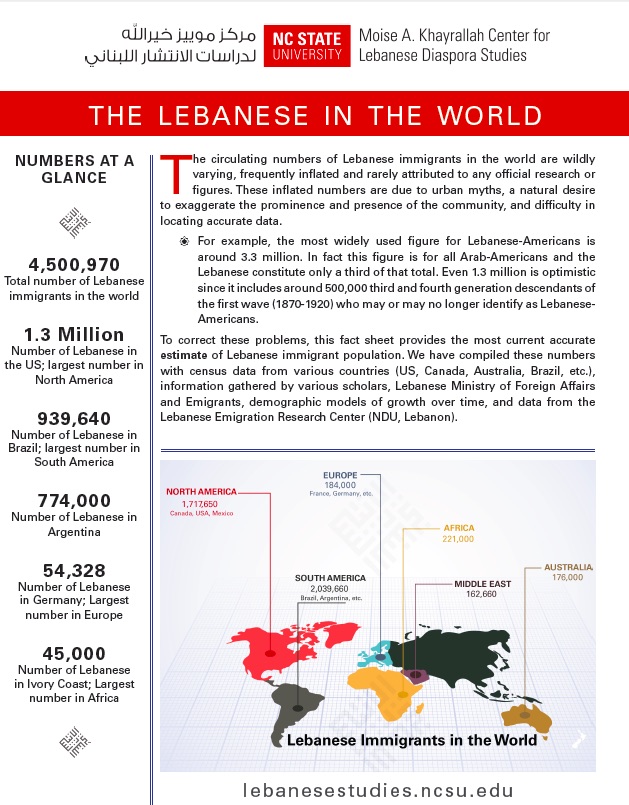Methods of Finding Population Statistics of Lebanese Migration Throughout the World
This blog post was written by Megan Cullen, Research Assistant for the Khayrallah Center.
In late September 2014, I became a Research Assistant for the Moise A. Khayrallah Center for Lebanese Diaspora Studies. My project investigated the patterns of Lebanese migration throughout the world, in order to establish the most reliable estimates of current diaspora populations. Based on this research, we produced a 1 page information sheet that provides an overview of the research results in visual and textual formats. While there are certainly many estimates of Lebanese diasporic populations, most of these numbers proved to be speculative or inflated. In order to determine original and accurate data, I did not utilize these numbers during the initial stages of my research. Rather, I began by combing through various scholarly texts such as So Far From Allah, So Close to Mexico by Theresa Alfaro-Velcamp, as well as articles by Colin Lindsay, B. Labiki, Paul Tabar, and Guita Hourani. I consulted various databases, including the Brazilian Institute of Geography and Statistics, the Arab American Institute, and several national censuses. Additional consideration was given to the Migration Policy Center, as well as the useful text, Lebanese in the World: A Century of Emigration, edited by Albert Hourani and Nadim Shehadi.
Download a PDF of the InfoSheet. I collected information regarding two major historical “waves” of Lebanese migration, as well as evaluated their global presence. With all those data points, I developed a working database. Because some of the population statistics were from several years ago, I utilized a population extrapolation formula in order for the numbers to reflect growth, as well as account for Lebanese descendants. To calculate the current population, I utilized the most recent statistics in order to determine a base population. After which, I calculated the annual growth rate of each subsequent year utilizing a 1% rate of growth. I chose this rate of growth because, as of 2010, the average annual population growth rate was estimated to be 1.2%. For the sake of simplicity, I chose to assume consistent growth. While this may not necessarily reflect reality, it actually provides a good approximation and is used by the World Bank and United Nations demographic units. These population growth estimations did not include direct migration, which was estimated separately and then combined into a total number. Each of the approximate estimations reflects Lebanese populations abroad as of the end of 2014. Conducting original research regarding the Lebanese populations throughout the world was problematic. As mentioned before, the current numbers are somewhat unreliable as they are usually inflated or based on outdated information. For example, certain countries present migration numbers that often incorporate other Middle Eastern groups into the count of the Lebanese. This lack of exclusivity results in misleading statistical information. Of all the countries with available statistics, Australia possessed the most thorough and recent documentation of Lebanese migration, and was by far the easiest to research. One of the most frequent obstacles that I encountered included conflicting sets of numbers for a certain country that were vastly different. In some instances, I was forced to average several numbers in order to determine a realistic mean. For instance, the United States is credited with having between 1.3 and 3.3 million Lebanese-Americans, depending on the source. In reality, the 3.3 million is the total number of Arab-Americans of whom the Lebanese represent only 1/3. Moreover, the 1.1 million Lebanese-Americans include descendants of the first wave (1880-1920) and that raises the question of how many members of this group (which represents around 500,000 of the total 1.1. million) consider themselves Lebanese-American. Another inherent problem that I encountered throughout my research was the inaccessibility caused by various language barriers. For instance, accessing the Brazilian Institute of Geography and Statistics website in order to view their census records was time-consuming, as most of the tables and information that I required were in Portuguese. Probably the most unfortunate aspect of the project was the fact that Lebanon has not conducted a national census in over 80 years, which would have allowed me to correlate the migration numbers with those of other countries. One source speculates that the reason Lebanon has not conducted a census of their residents is due to the sensitivity and political contentiousness of the issue. While the research was challenging, it also revealed exciting potential for further investigation into Lebanese population analysis. Social factors greatly contributed to Lebanese migration, including the Lebanese Civil War, which began in the 1970s. However, contemporary Lebanese migration patterns have not been thoroughly investigated and would benefit from additional research. Additional analysis into descendent identity, and whether or not certain descendants consider themselves to be Lebanese, would also be an influential consideration. Despite the potential problems, the numbers compiled and presented by this research are more than informed speculation. They are valuable and practical estimations of Lebanese populations abroad, which provide a necessary resource for further scholarship and research.
- Categories:



